RNA
-
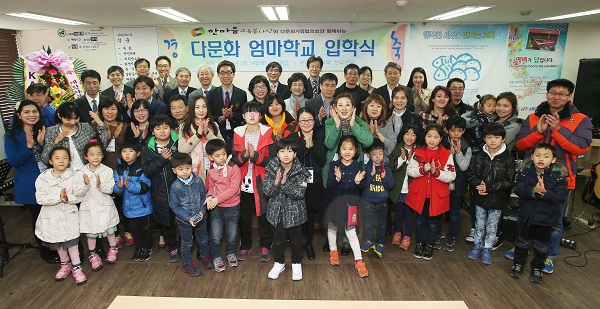 Emeritus Professors' Social Service for Embracing Multicultural Families
Korea has become a melting pot over recent years, with many families embracing diverse nationalities, cultures, and ethnicities. A group of KAIST emeritus professors volunteered to help these multicultural families, which are often formed through international marriages, better cope with life in Korea by creating a continuing education program called “Multicultural Mother School.”
The school admitted a total of ten non-Korean mothers for its first class and held an entrance ceremony for the students on March 14, 2015, at the IFC Hope Church in Daejeon. Classes began since March 16, 2015, offering the first lecture to students remotely via the Internet.
Professor Emeritus Byung-Kyu Choi, who organized the volunteering program and is the director of the Multicultural Mother School, said, “About 5% of newborns in Korea currently come from multicultural families. It is important that we should support them to assimilate well into the Korean society. Since 60% of multicultural children have yet to enter the public school system, particularly at the elementary schools level, offering their mothers opportunities to learn more about Korea will serve a greater good.”
2015.03.14 View 6874
Emeritus Professors' Social Service for Embracing Multicultural Families
Korea has become a melting pot over recent years, with many families embracing diverse nationalities, cultures, and ethnicities. A group of KAIST emeritus professors volunteered to help these multicultural families, which are often formed through international marriages, better cope with life in Korea by creating a continuing education program called “Multicultural Mother School.”
The school admitted a total of ten non-Korean mothers for its first class and held an entrance ceremony for the students on March 14, 2015, at the IFC Hope Church in Daejeon. Classes began since March 16, 2015, offering the first lecture to students remotely via the Internet.
Professor Emeritus Byung-Kyu Choi, who organized the volunteering program and is the director of the Multicultural Mother School, said, “About 5% of newborns in Korea currently come from multicultural families. It is important that we should support them to assimilate well into the Korean society. Since 60% of multicultural children have yet to enter the public school system, particularly at the elementary schools level, offering their mothers opportunities to learn more about Korea will serve a greater good.”
2015.03.14 View 6874 -
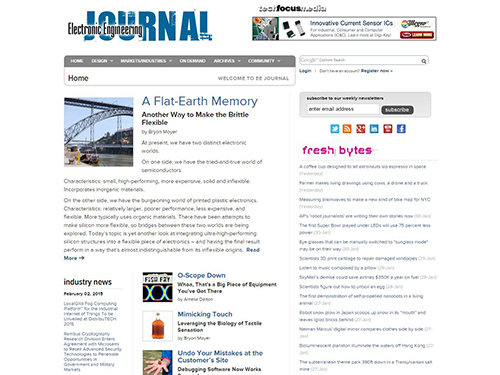 News Article: Flexible, High-performance Nonvolatile Memory Developed with SONOS Technology
Professor Yang-Kyu Choi of KAIST’s Department of Electrical Engineering and his team presented a research paper entitled “Flexible High-performance Nonvolatile Memory by Transferring GAA Silicon Nanowire SONOS onto a Plastic Substrate” at the conference of the International Electron Devices Meeting that took place on December 15-17, 2014 in San Francisco.
The Electronic Engineering Journal (http://www.eejournal.com/) recently posted an article on the paper:
Electronic Engineering Journal, February 2, 2015
“A Flat-Earth Memory”
Another Way to Make the Brittle Flexible
http://www.techfocusmedia.net/archives/articles/20150202-flexiblegaa/?printView=true
2015.02.03 View 8424
News Article: Flexible, High-performance Nonvolatile Memory Developed with SONOS Technology
Professor Yang-Kyu Choi of KAIST’s Department of Electrical Engineering and his team presented a research paper entitled “Flexible High-performance Nonvolatile Memory by Transferring GAA Silicon Nanowire SONOS onto a Plastic Substrate” at the conference of the International Electron Devices Meeting that took place on December 15-17, 2014 in San Francisco.
The Electronic Engineering Journal (http://www.eejournal.com/) recently posted an article on the paper:
Electronic Engineering Journal, February 2, 2015
“A Flat-Earth Memory”
Another Way to Make the Brittle Flexible
http://www.techfocusmedia.net/archives/articles/20150202-flexiblegaa/?printView=true
2015.02.03 View 8424 -
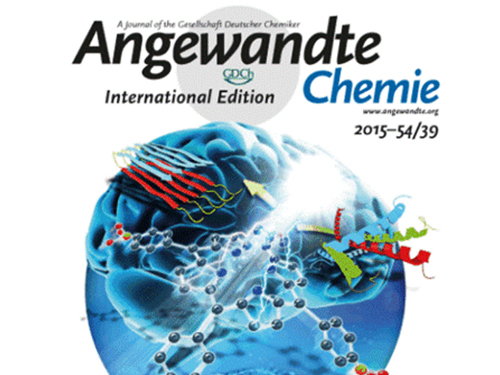 Light Driven Drug-Enzyme Reaction Catalytic Platform Developed
Low Cost Dye Used, Hope for Future Development of High Value Medicinal Products to Treat Cardiovascular Disease and Gastric Ulcers
A KAIST research team from the Departments of Materials Science and Engineering and of Chemical and Biomolecular Engineering, led respectively by Professors Chan Beum Park and Ki Jun Jeong, has developed a new reaction platform to induce drug-enzyme reaction using light.
The research results were published in the journal Angewandte Chemie, International Edition, as the back cover on 12 January 2015.
Applications of this technology may enable production of high value products such as medicine for cardiovascular disease and gastric ulcers, for example Omeprazole, using an inexpensive dye.
Cytochrome P450 is an enzyme involved in oxidative response which has an important role in drug and hormone metabolism in organisms. It is known to be responsible for metabolism of 75% of drugs in humans and is considered a fundamental factor in new drug development.
To activate cytochrome P450, the enzyme must receive an electron by reducing the enzyme. In addition, NADPH (a coenzyme) needs to be present. However, since NADPH is expensive, the use of cytochrome P450 was limited to the laboratory and has not yet been commercialized.
The research team used photosensitizer eosin Y instead of NADPH to develop “Whole Cell Photo-Biocatalysis” in bacteria E. coli. By exposing inexpensive eosin Y to light, cytochrome P450 reaction was catalyzed to produce the expensive metabolic material.
Professor Park said, “This research enabled industrial application of cytochrome P450 enzyme, which was previous limited.” He continued, “This technology will help greatly in producing high value medical products using cytochrome P450 enzyme.”
The research was funded by the National Research Foundation of Korea and KAIST's High Risk High Return Project (HRHRP).
Figure 1: Mimetic Diagram of Electron Transfer from Light to Cytochrome P450 Enzyme via Eosin Y, EY
Figure 2: The back cover of Angewandte Chemie published on 12 January 2015, showing the research results
2015.01.26 View 11446
Light Driven Drug-Enzyme Reaction Catalytic Platform Developed
Low Cost Dye Used, Hope for Future Development of High Value Medicinal Products to Treat Cardiovascular Disease and Gastric Ulcers
A KAIST research team from the Departments of Materials Science and Engineering and of Chemical and Biomolecular Engineering, led respectively by Professors Chan Beum Park and Ki Jun Jeong, has developed a new reaction platform to induce drug-enzyme reaction using light.
The research results were published in the journal Angewandte Chemie, International Edition, as the back cover on 12 January 2015.
Applications of this technology may enable production of high value products such as medicine for cardiovascular disease and gastric ulcers, for example Omeprazole, using an inexpensive dye.
Cytochrome P450 is an enzyme involved in oxidative response which has an important role in drug and hormone metabolism in organisms. It is known to be responsible for metabolism of 75% of drugs in humans and is considered a fundamental factor in new drug development.
To activate cytochrome P450, the enzyme must receive an electron by reducing the enzyme. In addition, NADPH (a coenzyme) needs to be present. However, since NADPH is expensive, the use of cytochrome P450 was limited to the laboratory and has not yet been commercialized.
The research team used photosensitizer eosin Y instead of NADPH to develop “Whole Cell Photo-Biocatalysis” in bacteria E. coli. By exposing inexpensive eosin Y to light, cytochrome P450 reaction was catalyzed to produce the expensive metabolic material.
Professor Park said, “This research enabled industrial application of cytochrome P450 enzyme, which was previous limited.” He continued, “This technology will help greatly in producing high value medical products using cytochrome P450 enzyme.”
The research was funded by the National Research Foundation of Korea and KAIST's High Risk High Return Project (HRHRP).
Figure 1: Mimetic Diagram of Electron Transfer from Light to Cytochrome P450 Enzyme via Eosin Y, EY
Figure 2: The back cover of Angewandte Chemie published on 12 January 2015, showing the research results
2015.01.26 View 11446 -
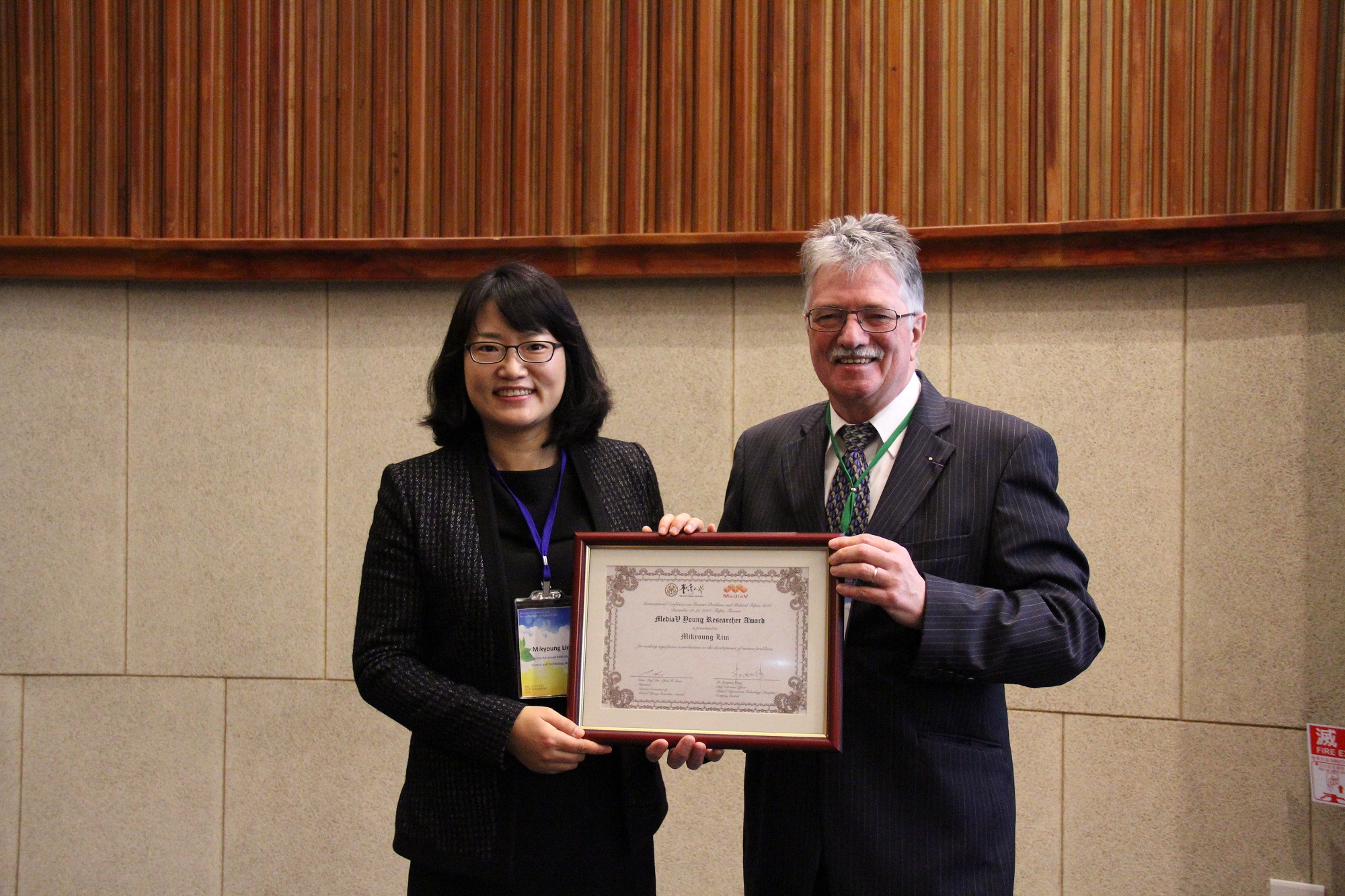 Professor Mikyoung Lim Receives the MediaV Young Researcher Award
Professor Mikyoung Lim of the Department of Mathematical Sciences at KAIST received the MediaV Young Researchers Award at the International Conference on Inverse Problems and Related Topics that took place at the National Taiwan University, Taiwan, on December 15-19, 2014.
The Conference established the MediaV Young Researcher Award in 2010 to recognize distinguished scholars who are age 40 or younger and have made important contributions to the field of inverse problems. This year, two recipients were chosen for the award.
Professor Lim has focused her research on the incremental reading of incomprehensible materials’ imaging and the effect of invisibility cloaking.
The other awardee was Kui Ren, a professor at the University of Texas at Austin.
2014.12.27 View 12566
Professor Mikyoung Lim Receives the MediaV Young Researcher Award
Professor Mikyoung Lim of the Department of Mathematical Sciences at KAIST received the MediaV Young Researchers Award at the International Conference on Inverse Problems and Related Topics that took place at the National Taiwan University, Taiwan, on December 15-19, 2014.
The Conference established the MediaV Young Researcher Award in 2010 to recognize distinguished scholars who are age 40 or younger and have made important contributions to the field of inverse problems. This year, two recipients were chosen for the award.
Professor Lim has focused her research on the incremental reading of incomprehensible materials’ imaging and the effect of invisibility cloaking.
The other awardee was Kui Ren, a professor at the University of Texas at Austin.
2014.12.27 View 12566 -
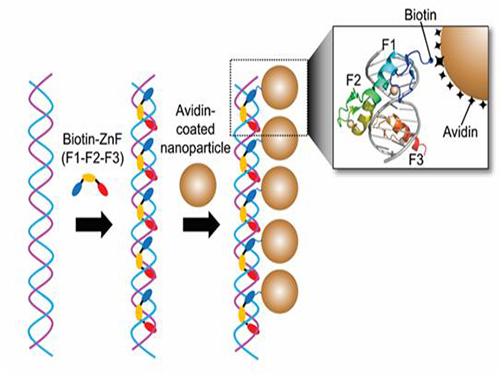 Nanoparticle Cluster Manufacturing Technique Using DNA Binding Protein Developed
Professor Hak-Sung Kim of the Department of Biological Sciences at KAIST and Yiseul Ryu, a doctoral candidate, used the Zinc Finger protein that specifically binds to target DNA sequence to develop a new manufacturing technique for size-controllable magnetic Nanoparticle Clusters (NPCs). Their research results were published in Angewandte Chemie International Edition online on 25 November 2014.
NPCs are structures consisting of magnetic nanoparticles, gold nanoparticles, and quantum dots, each of which are smaller than 100 nm (10-9m). NPCs have a distinctive property of collectivity not seen in single nanoparticles.
Specifically NPCS differ in physical and optical properties such as Plasmon coupling absorbance, energy transfers between particles, electron transfers, and conductivity. Therefore, NPCs can be employed in biological and medical research as well as the development of nanoelectric and nanoplasmon devices.
To make use of these novel properties, the size and the composition of the cluster must be exquisitely controlled. However, previous techniques relied on chemical binding which required complex steps, making it difficult to control the size and composition of NPCs.
Professor Kim’s team used Zinc Finger, a DNA binding protein, to develop a NPCs manufacturing technique to create clusters of the desired size easily. The Zinc Finger protein contains a zinc ion and specifically recognizes DNA sequence upon binding, which allows the exquisite control of the size and the cluster composition. The technique is also bio-friendly.
Professor Kim’s team created linear structure of different sizes of NPCs using Zinc Finger proteins and three DNA sequences of different lengths. The NPCs they produced confirmed their ability to control the size and structure of the cluster by using different DNA lengths.
The NPCs showed tripled T2 relaxation rates compared to the existing MRI contrast media (Feridex) and effectively transported to targeted cells. The research findings show the potential use of NPCs in biological and medical fields such as MRI contrast media, fluorescence imaging, and drug transport.
The research used the specific binding property of protein and DNA to develop a new method to create an inorganic nanoparticle’s supramolecular assembly. The technique can be used and applied extensively in other nanoparticles for future research in diagnosis, imaging, and drug and gene delivery.
Figure 1. A Mimetic Diagram of NPCs Manufacturing Technique Using DNA Binding Protein Zinc Finger
Figure 2. Transmission Electron Microscopy Images showing different sizes of NPCs depending on the length of the DNA
2014.12.04 View 14459
Nanoparticle Cluster Manufacturing Technique Using DNA Binding Protein Developed
Professor Hak-Sung Kim of the Department of Biological Sciences at KAIST and Yiseul Ryu, a doctoral candidate, used the Zinc Finger protein that specifically binds to target DNA sequence to develop a new manufacturing technique for size-controllable magnetic Nanoparticle Clusters (NPCs). Their research results were published in Angewandte Chemie International Edition online on 25 November 2014.
NPCs are structures consisting of magnetic nanoparticles, gold nanoparticles, and quantum dots, each of which are smaller than 100 nm (10-9m). NPCs have a distinctive property of collectivity not seen in single nanoparticles.
Specifically NPCS differ in physical and optical properties such as Plasmon coupling absorbance, energy transfers between particles, electron transfers, and conductivity. Therefore, NPCs can be employed in biological and medical research as well as the development of nanoelectric and nanoplasmon devices.
To make use of these novel properties, the size and the composition of the cluster must be exquisitely controlled. However, previous techniques relied on chemical binding which required complex steps, making it difficult to control the size and composition of NPCs.
Professor Kim’s team used Zinc Finger, a DNA binding protein, to develop a NPCs manufacturing technique to create clusters of the desired size easily. The Zinc Finger protein contains a zinc ion and specifically recognizes DNA sequence upon binding, which allows the exquisite control of the size and the cluster composition. The technique is also bio-friendly.
Professor Kim’s team created linear structure of different sizes of NPCs using Zinc Finger proteins and three DNA sequences of different lengths. The NPCs they produced confirmed their ability to control the size and structure of the cluster by using different DNA lengths.
The NPCs showed tripled T2 relaxation rates compared to the existing MRI contrast media (Feridex) and effectively transported to targeted cells. The research findings show the potential use of NPCs in biological and medical fields such as MRI contrast media, fluorescence imaging, and drug transport.
The research used the specific binding property of protein and DNA to develop a new method to create an inorganic nanoparticle’s supramolecular assembly. The technique can be used and applied extensively in other nanoparticles for future research in diagnosis, imaging, and drug and gene delivery.
Figure 1. A Mimetic Diagram of NPCs Manufacturing Technique Using DNA Binding Protein Zinc Finger
Figure 2. Transmission Electron Microscopy Images showing different sizes of NPCs depending on the length of the DNA
2014.12.04 View 14459 -
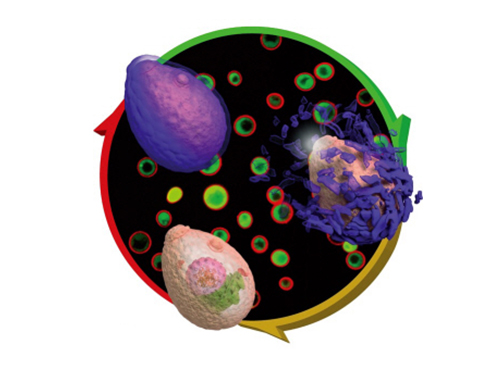 Eggshell-like Cell Encapsulation and Degradation Technology Developed
Some bacteria form endospores on cell walls to protect their DNA in case of nutrient deficiency. When an endospore meets a suitable environment for survival, the cell can revert to the original state from which it can reproduce.
The technique that can artificially control such phenomenon was developed by an international team of researchers. At first, a cell is wrapped and preserved like an egg. When the cell is needed, the technique allows the endospore to decompose while it is alive. Future applications for this technique include cell-based biosensor, cell therapy, and biocatalyst processes.
Professors Insung Choi and Younghoon Lee from the Department of Chemistry at KAIST as well as and Professor Frank Caruso from the University of Melbourne developed this technique which permits a cell to stay alive by coating it with film on a nanometer scale and then to be decomposed while it is alive.
The research finding was published in the November 10th issue of Angewandte Chemie International Edition as the lead article.
Cell encapsulation allows researchers to capture a cell in a tight capsule while it is alive. It is highly recognized in cell-based applications where the control of cell stability and cell-division is the biggest issue.
Traditional cell encapsulation methods utilized organic film or inorganic capsules that are made of organic film moldings. Although these films tightly closed around the cell, because they were not easily decomposable, it was difficult to apply the method.
The research team succeeded in encapsulating each cell in a metal-polyphenol film by mixing tannic acid and iron ion solution with yeast cells.
Usually extracted from oak barks or grape peels, tannic acid is a natural substance. It forms a metal-polyphenol film within ten seconds when it meets iron ions due to its high affinity with cells. Cells encapsulated with this film presented high survival rates. Since the film forms quickly in a simple manner, it was possible to obtain large amount of encapsulated cells.
The research team also found that the metal-polyphenol film was stable in neutral pH, but is easily degradable under a weak acidic condition. Using this property, they were able to control cell division by restoring the cell to its pre-encapsulated state at a desired moment.
Protecting the cell from the external environment like an egg shell, the metal-polyphenol film protected the cell against foreign conditions such as lytic enzymes, extended exposure to UV radiation, and silver nanoparticles. The research indicated that the encapsulated cells had a high survival rate even under extreme environments.
Professor Lee said that “not only the cells remain alive during the encapsulation stage, but also they can be protected under extreme environment.” He added, “This is an advanced cell encapsulation technology that allows controlling cell-division of those cells through responsive shell degradation on-demand.”
Professor Choi commented, “Although the cell encapsulation technology is still in its infancy, as the technology matures the application of cell-manipulation technology will be actualized.” He highlighted that “it will serve as a breakthrough to problems faced by cell-based applications.”
Sponsored by the Ministry of Science, ICT and Future Planning and the National Research Foundation of Korea, the research was led by two Master’s candidates, Ji Hun Park and Kyung Hwan Kim, under the joint guidance of research professors from KAIST and the University of Melbourne.
Figure 1: Lead article of Angewandte Chemie
Background: Shows a live native yeast (in green) encapsulated in a metal-polyphenol film (in red) illustrating the vitality of the yeast
Front: A native yeast at each encapsulation stage
Pictured on the bottom left is a cell prior to encapsulation. Following the red arrow, the native yeast is in purple to show metal-polyphenol film formed around the cell. The cell after the green arrow is a visualization of the degradation of the film in weak acidic condition.
Figure 2: A mimetic diagram of cell encapsulation with a metal-polyphenol film
Top: A native yeast before encapsulation
Middle: A native yeast encapsulated with Tannic Acid-Fe (III) Nanoshell – cell-division of the encapsulated cell is controlled by pH and the shell is protected against silver nanoparticle, lytic enzyme, and UV-C
Bottom: Shell degradation on-demand depending on pH
2014.11.18 View 11242
Eggshell-like Cell Encapsulation and Degradation Technology Developed
Some bacteria form endospores on cell walls to protect their DNA in case of nutrient deficiency. When an endospore meets a suitable environment for survival, the cell can revert to the original state from which it can reproduce.
The technique that can artificially control such phenomenon was developed by an international team of researchers. At first, a cell is wrapped and preserved like an egg. When the cell is needed, the technique allows the endospore to decompose while it is alive. Future applications for this technique include cell-based biosensor, cell therapy, and biocatalyst processes.
Professors Insung Choi and Younghoon Lee from the Department of Chemistry at KAIST as well as and Professor Frank Caruso from the University of Melbourne developed this technique which permits a cell to stay alive by coating it with film on a nanometer scale and then to be decomposed while it is alive.
The research finding was published in the November 10th issue of Angewandte Chemie International Edition as the lead article.
Cell encapsulation allows researchers to capture a cell in a tight capsule while it is alive. It is highly recognized in cell-based applications where the control of cell stability and cell-division is the biggest issue.
Traditional cell encapsulation methods utilized organic film or inorganic capsules that are made of organic film moldings. Although these films tightly closed around the cell, because they were not easily decomposable, it was difficult to apply the method.
The research team succeeded in encapsulating each cell in a metal-polyphenol film by mixing tannic acid and iron ion solution with yeast cells.
Usually extracted from oak barks or grape peels, tannic acid is a natural substance. It forms a metal-polyphenol film within ten seconds when it meets iron ions due to its high affinity with cells. Cells encapsulated with this film presented high survival rates. Since the film forms quickly in a simple manner, it was possible to obtain large amount of encapsulated cells.
The research team also found that the metal-polyphenol film was stable in neutral pH, but is easily degradable under a weak acidic condition. Using this property, they were able to control cell division by restoring the cell to its pre-encapsulated state at a desired moment.
Protecting the cell from the external environment like an egg shell, the metal-polyphenol film protected the cell against foreign conditions such as lytic enzymes, extended exposure to UV radiation, and silver nanoparticles. The research indicated that the encapsulated cells had a high survival rate even under extreme environments.
Professor Lee said that “not only the cells remain alive during the encapsulation stage, but also they can be protected under extreme environment.” He added, “This is an advanced cell encapsulation technology that allows controlling cell-division of those cells through responsive shell degradation on-demand.”
Professor Choi commented, “Although the cell encapsulation technology is still in its infancy, as the technology matures the application of cell-manipulation technology will be actualized.” He highlighted that “it will serve as a breakthrough to problems faced by cell-based applications.”
Sponsored by the Ministry of Science, ICT and Future Planning and the National Research Foundation of Korea, the research was led by two Master’s candidates, Ji Hun Park and Kyung Hwan Kim, under the joint guidance of research professors from KAIST and the University of Melbourne.
Figure 1: Lead article of Angewandte Chemie
Background: Shows a live native yeast (in green) encapsulated in a metal-polyphenol film (in red) illustrating the vitality of the yeast
Front: A native yeast at each encapsulation stage
Pictured on the bottom left is a cell prior to encapsulation. Following the red arrow, the native yeast is in purple to show metal-polyphenol film formed around the cell. The cell after the green arrow is a visualization of the degradation of the film in weak acidic condition.
Figure 2: A mimetic diagram of cell encapsulation with a metal-polyphenol film
Top: A native yeast before encapsulation
Middle: A native yeast encapsulated with Tannic Acid-Fe (III) Nanoshell – cell-division of the encapsulated cell is controlled by pH and the shell is protected against silver nanoparticle, lytic enzyme, and UV-C
Bottom: Shell degradation on-demand depending on pH
2014.11.18 View 11242 -
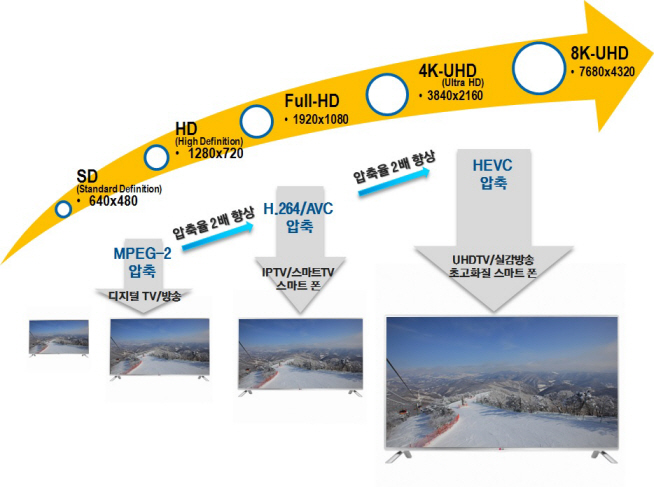 KAIST Registers an Internationally Recognized Standard Patent
A video compression technology, jointly developed by Professor Mun-Chul Kim of the Department of Electrical Engineering at KAIST, the Electronics and Telecommunications Research Institute (ETRI), and the Korean Broadcasting System (KBS), is registered internationally as the standard patent in the next-generation High Efficiency Video Coding (HEVC).
HEVC (H.265) is an international technology standard that compresses large image data for Ultra High Definition (UHD) televisions and smartphones. It has the twice the compression efficiency as that of H.264/AVC which is most commonly used for processing full HD sources. This means that it is able to compress a video file to half the size while maintaining the same image quality.
Although the related market is at a nascent stage, HEVC technology has already been applied to the latest version of televisions and smartphones. Experts predict that the market will grow to USD 200 billion by 2016, and KAIST is expected to receive a royalty payment of USD 9.3 million from this patent.
The International Organization for Standardization (ISO/IEC) established the HEVC standard in January 2013. Also, an international patent pool licensing corporation, MPEG LA announced the HEVC standard patent pool on September 29, 2014.
Professor Joongmyeon Bae, Dean of the Office of University-Industry Cooperation (OUIC) of KAIST, said, “This is an unprecedented case for Korea whereby a core technology developed by a university became an international standard, which has a vast impact on the market.”
President of KAIST, Steve Kang commented, “With its advanced technology, KAIST joined the HEVC standard patent pool as one of the 23 founding members along with Apple, Siemens, and NEC. This is a remarkable achievement.”
Picture 1: Improvements in video compression technology
Picture 2: Comparison of different screen resolutions
2014.10.09 View 14207
KAIST Registers an Internationally Recognized Standard Patent
A video compression technology, jointly developed by Professor Mun-Chul Kim of the Department of Electrical Engineering at KAIST, the Electronics and Telecommunications Research Institute (ETRI), and the Korean Broadcasting System (KBS), is registered internationally as the standard patent in the next-generation High Efficiency Video Coding (HEVC).
HEVC (H.265) is an international technology standard that compresses large image data for Ultra High Definition (UHD) televisions and smartphones. It has the twice the compression efficiency as that of H.264/AVC which is most commonly used for processing full HD sources. This means that it is able to compress a video file to half the size while maintaining the same image quality.
Although the related market is at a nascent stage, HEVC technology has already been applied to the latest version of televisions and smartphones. Experts predict that the market will grow to USD 200 billion by 2016, and KAIST is expected to receive a royalty payment of USD 9.3 million from this patent.
The International Organization for Standardization (ISO/IEC) established the HEVC standard in January 2013. Also, an international patent pool licensing corporation, MPEG LA announced the HEVC standard patent pool on September 29, 2014.
Professor Joongmyeon Bae, Dean of the Office of University-Industry Cooperation (OUIC) of KAIST, said, “This is an unprecedented case for Korea whereby a core technology developed by a university became an international standard, which has a vast impact on the market.”
President of KAIST, Steve Kang commented, “With its advanced technology, KAIST joined the HEVC standard patent pool as one of the 23 founding members along with Apple, Siemens, and NEC. This is a remarkable achievement.”
Picture 1: Improvements in video compression technology
Picture 2: Comparison of different screen resolutions
2014.10.09 View 14207 -
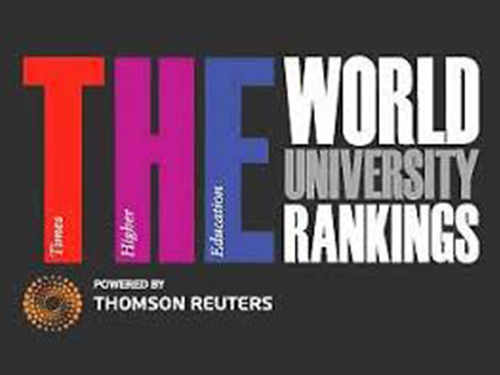 KAIST Ranks 26th in Engineering & Technology and 52nd overall in the Times Higher Education World University Rankings 2014-2015
The 2014-2015 Times Higher Education (THE) World University Rankings were released on October 1, 2014. KAIST took 52nd place in the overall rankings and 26th in the field of engineering and technology.
THE used 13 performance indicators to evaluate universities, grouping them into five areas of teaching, research, citations, industry income, and international outlook.
In recent years, KAIST has seen steady improvements in areas of research, citations, and international outlook. In addition to KAIST, two Korean universities, Seoul National University (50th) and Pohang University of Science and Technology (66th), were included within the top 100 universities.
For details, please visit:
http://www.timeshighereducation.co.uk/world-university-rankings/2014-15/world-ranking.
2014.10.03 View 9354
KAIST Ranks 26th in Engineering & Technology and 52nd overall in the Times Higher Education World University Rankings 2014-2015
The 2014-2015 Times Higher Education (THE) World University Rankings were released on October 1, 2014. KAIST took 52nd place in the overall rankings and 26th in the field of engineering and technology.
THE used 13 performance indicators to evaluate universities, grouping them into five areas of teaching, research, citations, industry income, and international outlook.
In recent years, KAIST has seen steady improvements in areas of research, citations, and international outlook. In addition to KAIST, two Korean universities, Seoul National University (50th) and Pohang University of Science and Technology (66th), were included within the top 100 universities.
For details, please visit:
http://www.timeshighereducation.co.uk/world-university-rankings/2014-15/world-ranking.
2014.10.03 View 9354 -
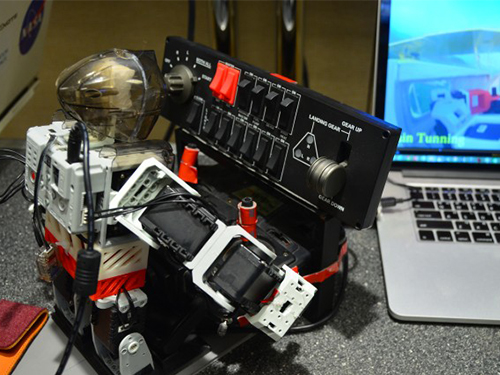 PIBOT, a small humanoid robot flies an aircraft
The 2014 IEEE/RSJ International Conference on Intelligent Robots and Systems (IROS 2014) took place in Chicago, Illinois, on September 14-18, 2014.
Professor David Hyunchul Shim and his students from the Department of Aerospace Engineering, KAIST, presented a research paper entitled “A Robot-machine Interface for Full-functionality Automation Using a Humanoid” at the conference.
The robot called “PIBOT,” a pint-sized, tiny humanoid robot, uses a mixture of flight data and visuals to fly an airplane, capable of identifying and operating all of the buttons and switches in the cockpit of a normal light aircraft designed for humans.
For now, the robot is only flying a simulator, but Professor Shim expects that “PIBOT will help us have a fully automated flight experience, eventually replacing human pilots.”
The IEEE Spectrum magazine published an article on PIBOT posted online September 18, 2014. Please follow the link below for the article:
IEEE Spectrum, September 18, 2014
Tiny Humanoid Robot Learning to Fly Real Airplanes
http://spectrum.ieee.org/automaton/robotics/humanoids/tiny-humanoid-robot-learning-to-fly-real-airplanes
2014.09.23 View 14981
PIBOT, a small humanoid robot flies an aircraft
The 2014 IEEE/RSJ International Conference on Intelligent Robots and Systems (IROS 2014) took place in Chicago, Illinois, on September 14-18, 2014.
Professor David Hyunchul Shim and his students from the Department of Aerospace Engineering, KAIST, presented a research paper entitled “A Robot-machine Interface for Full-functionality Automation Using a Humanoid” at the conference.
The robot called “PIBOT,” a pint-sized, tiny humanoid robot, uses a mixture of flight data and visuals to fly an airplane, capable of identifying and operating all of the buttons and switches in the cockpit of a normal light aircraft designed for humans.
For now, the robot is only flying a simulator, but Professor Shim expects that “PIBOT will help us have a fully automated flight experience, eventually replacing human pilots.”
The IEEE Spectrum magazine published an article on PIBOT posted online September 18, 2014. Please follow the link below for the article:
IEEE Spectrum, September 18, 2014
Tiny Humanoid Robot Learning to Fly Real Airplanes
http://spectrum.ieee.org/automaton/robotics/humanoids/tiny-humanoid-robot-learning-to-fly-real-airplanes
2014.09.23 View 14981 -
 QS World University Rankings 2014: KAIST ranked 17th in Engineering and Technology
The QS World University Rankings 2014 were released on October 16, 2014. KAIST ranked 51st among the top 100 global universities which included Massachusetts Institute of Technology (MIT), University of Cambridge, Imperial College London, Harvard University, and University of Oxford. This year’s QS ranking is the highest record ever achieved by KAIST, a great leap from last year’s 60th.
KAIST’s forte in engineering and technology remains high, ranking 17th out of hundreds of universities around the world. Since 2004, KAIST has kept the number one place in this subject within Korea.
Since first being compiled in 2004, the QS rankings have expanded to feature more than 800 universities around the world, and the top 400 universities are given individual ranking positions. The rankings are compiled based on six indicators: academic reputation, employer reputation, faculty/student ratio, citations per faculty, international student ratio, and international staff ratio.
KAIST has earned high scores in three indicators: citations per faculty, academic reputation, and employer reputation.
President Steve Kang of KAIST said, “With concerted efforts made by all members of the KAIST community, faculty and students in particular, we have received a good result in the global rankings. Without dwelling on this result, we will continue to strive toward making KAIST one of the most sought-after universities in the world, academically praised and technologically innovative.”
2014.09.16 View 9430
QS World University Rankings 2014: KAIST ranked 17th in Engineering and Technology
The QS World University Rankings 2014 were released on October 16, 2014. KAIST ranked 51st among the top 100 global universities which included Massachusetts Institute of Technology (MIT), University of Cambridge, Imperial College London, Harvard University, and University of Oxford. This year’s QS ranking is the highest record ever achieved by KAIST, a great leap from last year’s 60th.
KAIST’s forte in engineering and technology remains high, ranking 17th out of hundreds of universities around the world. Since 2004, KAIST has kept the number one place in this subject within Korea.
Since first being compiled in 2004, the QS rankings have expanded to feature more than 800 universities around the world, and the top 400 universities are given individual ranking positions. The rankings are compiled based on six indicators: academic reputation, employer reputation, faculty/student ratio, citations per faculty, international student ratio, and international staff ratio.
KAIST has earned high scores in three indicators: citations per faculty, academic reputation, and employer reputation.
President Steve Kang of KAIST said, “With concerted efforts made by all members of the KAIST community, faculty and students in particular, we have received a good result in the global rankings. Without dwelling on this result, we will continue to strive toward making KAIST one of the most sought-after universities in the world, academically praised and technologically innovative.”
2014.09.16 View 9430 -
 2014 NEREC Conference on Nuclear Nonproliferation: July 31-August 1, 2014, Seoul
The Nonproliferation Education and Research Center (NEREC) at KAIST hosted an international conference on nuclear nonproliferation on July 31-August 1, 2014 in Seoul. The Ministry of Science, ICT and Future Planning, the Korean Nuclear Safety and Security Commission, and the Korea Nuclear Policy Society (KNPS) sponsored the event.
Over one hundred experts and "thought leaders" in nuclear security and nonproliferation attended the conference and discussed issues related to the nonproliferation of nuclear weapons, the role of scientific community in mitigating nuclear threat and promoting the peaceful use of nuclear power, and nuclear disarmament policy.
Keynote speakers were: Steven E. Miller, Director of International Security Program at Belfer Center for Science and International Affairs, Harvard University; Scott D. Sagan, Senior Fellow of the Center for International Security and Cooperation, Freeman Spogli Institute for International Studies, Stanford University; Mark Fitzpatrick, Director of the Nonproliferation and Disarmament Programme, International Institute for Strategic Studies; Sang-Hyun Lee, Director of Security Strategy, Sejong Institute; and Man-Sung Yim, Professor of Nuclear and Quantum Engineering, KAIST.
At the conference, Professor Yim, Director of KAIST NEREC said, “Korea has grown to become a key player in the development of commercial nuclear energy over the past decades. We hope that our conference encourages Korea to be more involved in the efforts of the international community to enhance the global nonproliferation regime.”
2014.08.05 View 15944
2014 NEREC Conference on Nuclear Nonproliferation: July 31-August 1, 2014, Seoul
The Nonproliferation Education and Research Center (NEREC) at KAIST hosted an international conference on nuclear nonproliferation on July 31-August 1, 2014 in Seoul. The Ministry of Science, ICT and Future Planning, the Korean Nuclear Safety and Security Commission, and the Korea Nuclear Policy Society (KNPS) sponsored the event.
Over one hundred experts and "thought leaders" in nuclear security and nonproliferation attended the conference and discussed issues related to the nonproliferation of nuclear weapons, the role of scientific community in mitigating nuclear threat and promoting the peaceful use of nuclear power, and nuclear disarmament policy.
Keynote speakers were: Steven E. Miller, Director of International Security Program at Belfer Center for Science and International Affairs, Harvard University; Scott D. Sagan, Senior Fellow of the Center for International Security and Cooperation, Freeman Spogli Institute for International Studies, Stanford University; Mark Fitzpatrick, Director of the Nonproliferation and Disarmament Programme, International Institute for Strategic Studies; Sang-Hyun Lee, Director of Security Strategy, Sejong Institute; and Man-Sung Yim, Professor of Nuclear and Quantum Engineering, KAIST.
At the conference, Professor Yim, Director of KAIST NEREC said, “Korea has grown to become a key player in the development of commercial nuclear energy over the past decades. We hope that our conference encourages Korea to be more involved in the efforts of the international community to enhance the global nonproliferation regime.”
2014.08.05 View 15944 -
 Professor Min Hyuk Kim Appointed an Associate Editor on ACM Transactions on Graphics
Professor Min Hyuk Kim of KAIST's Computer Science Department has been appointed an associate editor for a prestigious international journal in the field of graphics, ACM Transactions on Graphics (TOG).
Founded in 1947, the Association for Computing Machinery (ACM) is the world’s largest educational and scientific computing society, delivering knowledge that advances computing as a science and profession.
Published during the past 35 years, ACM TOG is a highly regarded, peer-reviewed scientific journal that aims to disseminate the latest findings of research in computer graphics. Professor Kim is the first Korean scholar to serve the journal as an editor.
Professor Kim’s responsibilities are many, and they include selecting appropriate reviewers for submitted manuscripts to be published in the journal and reporting the results of review process.
He said, “The appointment was a great honor, and I’m looking forward to having the opportunity to make further contributions to the advancement of the graphics field.”
Professor Kim has published numerous papers on computer graphics with a focus on research in 3D imaging spectroscopy and visual perception.
2014.07.14 View 11477
Professor Min Hyuk Kim Appointed an Associate Editor on ACM Transactions on Graphics
Professor Min Hyuk Kim of KAIST's Computer Science Department has been appointed an associate editor for a prestigious international journal in the field of graphics, ACM Transactions on Graphics (TOG).
Founded in 1947, the Association for Computing Machinery (ACM) is the world’s largest educational and scientific computing society, delivering knowledge that advances computing as a science and profession.
Published during the past 35 years, ACM TOG is a highly regarded, peer-reviewed scientific journal that aims to disseminate the latest findings of research in computer graphics. Professor Kim is the first Korean scholar to serve the journal as an editor.
Professor Kim’s responsibilities are many, and they include selecting appropriate reviewers for submitted manuscripts to be published in the journal and reporting the results of review process.
He said, “The appointment was a great honor, and I’m looking forward to having the opportunity to make further contributions to the advancement of the graphics field.”
Professor Kim has published numerous papers on computer graphics with a focus on research in 3D imaging spectroscopy and visual perception.
2014.07.14 View 11477